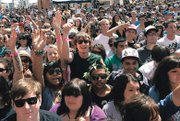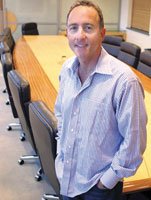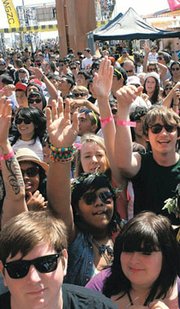PacSun CEO Talks Surf Chain's Big Changes
After Pacific Sunwear’s big party, the long-suffering retailer hopes people will see the brand in a new way.
The Anaheim, Calif.–based retailer of boardsports fashions produced its first festival, the PacSun Summer Solstice Beach Ballyhoo, on June 19 and 20. More than a reported 15,000 people traveled to the beach in Santa Monica, Calif., to listen to new rock bands play and to watch skateboarders seemingly defy gravity. The event was free to consumers who reserved tickets at PacSun stores. The retailer’s brands also received a high-profile marketing boost from the Ballyhoo.
Nike, Volcom, Hurley, RVCA, Quiksilver, Vans, Roxy and others set up booths and trailers at the Ballyhoo, where they gave thousands of concertgoers a view of their latest fashions, as well as exhibitions on the art and the lifestyle that made them unique.
The big event might dispel notions that PacSun is a fusty retailer out of touch with its customers. It’s a perception that PacSun Chief Executive Gary Schoenfeld has been working hard to dispel.
Schoenfeld was hired in June 2009 to turn around the business of the 883-store mall retailer. But PacSun has not reported positive same-store sales—the popular gauge for success—since the third fiscal quarter of 2007.
Since the beginning of the year, Schoenfeld has made several key hires to help him turn around the big fleet of PacSun stores. In April, Paula Lentini was hired as the senior vice president of retail. In February, former Urban Outfitters general manager Christine Lee was hired as PacSun’s general merchandise manager. In January, Levi’s marketer Robert Cameron was hired.
While Schoenfeld and his new team have been received well by retail analysts, the jury is still out on whether Schoenfeld has taken the right steps to save this company.
“It is not too late for Pacific Sunwear,” said Jeffrey Van Sinderen, an analyst with financial-services company B. Riley & Co. “They need to find the right formula to re-engage with their customer.”
Schoenfeld recently talked with California Apparel News about some of the initiatives and programs PacSun has undertaken to drive its comeback as one of the most popular shops at the mall.PacSun has been rebranding for the past year. What is the rebranding effort? How will PacSun be implementing it?
Gary Schoenfeld: PacSun has tremendous heritage. From the 1990s to 2005, it brought a whole new style—grounded in action sports—to teens throughout the country. In the past four years, we’ve gotten away from that and tried to compete more with the vertical retailers. I’m trying to combine the best of both worlds. It’s the best of the branded experience combined with the proprietary fashion that PacSun developed in more recent years that will give us the competitive edge against vertical retailers in the mall.How will PacSun rebrand with its merchandise?
G.S.: I think about brands in three groups: There are the heritage brands, such as Volcom, Hurley, Fox and Billabong. They are brands that, for the last 20 years, people have expected to find at PacSun. We’ve worked hard the last 12 months to re-engage with these brands to tap into their creativity with branding and marketing. The second is with proprietary brands, such as Bullhead and Kirra. Third, PacSun was always a destination with new and up-and-coming brands. We lost that over the past few years. We’re beginning to work more closely with RVCA, WESC, Insight and others, and we are looking to continue to add more of those kinds of brands to our mix as we go forward.
We started an artist collaboration that we have done internally within our own brands. I do anticipate working more closely with brands themselves and working some exclusive collaborations and products as we go forward. PacSun also is undertaking a localization program for its 883 stores. Could you talk more about this program?
G.S.: It starts to roll out into stores for Back-to-School season. It’s a hugely important step to place the right product in the right store for the right customer. For example, we won’t be selling hooded fleece and flannel shirts in hot-market stores starting in July. We also recognized some stores have a year-round shirt and sandals presentation. Some stores have more-fashion-forward customers. There also are variances in brand preferences around the country, each of which we have factored into assortments.
Core assortment will be the same around most stores. The overall assortment could vary 10 to 30 percent. Responsibility for localization relies with internal merchants in Anaheim [PacSun’s headquarters]. We’ve also gotten valuable input from the field. PacSun has been renegotiating its leases. Could you give an update?
G.S.: We’ve been actively engaged with landlords. They are not anxious to see stores close. We’ve been able to work out good partnerships with key landlords. Our store count will continue to diminish some. We’ll end this year with 850 to 870 stores.When do you forecast PacSun will report positive comps?
G.S.: The target we articulated was positive comps by the fourth quarter. We continue to aim to make that happen. I’m confident we will do so.What is the most challenging and rewarding part of trying to turn around PacSun?
G.S.: The most rewarding part is the talent we are attracting and the cultural shift that is taking place internally. Without the right people and the right sense of collaboration, creativity and accountability, we would not be able to fix the business. I’m quite pleased with the progress we’ve made, and I’m excited as we head into the back half of this year.


























